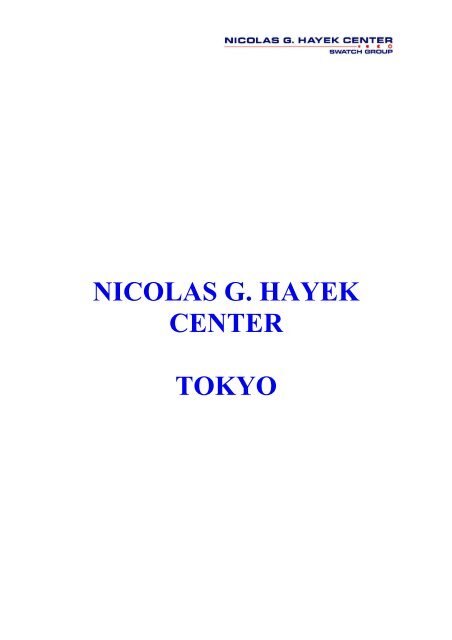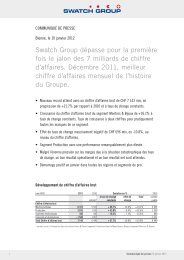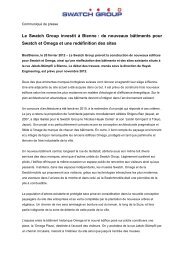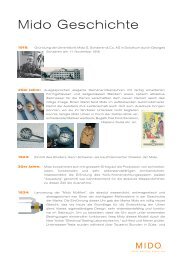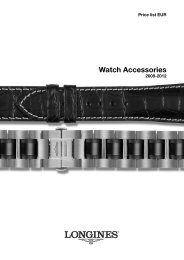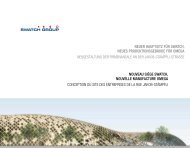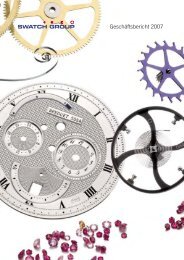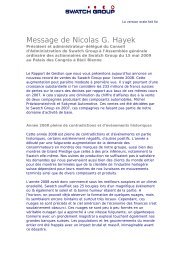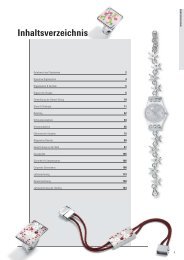PDF Document - Swatch Group
PDF Document - Swatch Group
PDF Document - Swatch Group
Create successful ePaper yourself
Turn your PDF publications into a flip-book with our unique Google optimized e-Paper software.
NICOLAS G. HAYEK<br />
CENTER<br />
TOKYO
GROUND BREAKING EVENT – JOURNEY TO THE HEART OF<br />
TRADITION<br />
Once upon a time, in the Land of the Rising Sun, lived the god of the earth, who<br />
everyone called Kami.<br />
Before going any further, it is important to know that Japan is full of tradition.<br />
The blossoming of cherry trees in April, auspicious occasions for asking for help<br />
from the gods, harvest time – all these warrant ceremonies, meals of infinite<br />
subtlety, floral arrangements, tea ceremonies. For the Japanese, this is a way of<br />
not losing contact with their roots. Nothing in the world would induce the<br />
Japanese people to forget their customs, so they keep a watchful eye on the<br />
celestial calendar and its mysteries, as well as the earthly calendar.<br />
So on October 23, 2005, even before construction had started on the NICOLAS<br />
G. HAYEK CENTER, the Jichinsai ceremony, a Shinto ritual aimed at<br />
summoning and appeasing Kami, god of the earth, was organized on a site<br />
specially set up for this purpose, in the heart of Ginza. This was so that work<br />
would proceed smoothly.<br />
The Jichinsai ritual is quite brief, and of a highly symbolic nature. It is said that<br />
if one does not submit to the ceremony, Kami will become angry, leading to the<br />
subsequent destruction of the edifice.<br />
This celebration is considered essential, even when the Japanese construct<br />
buildings abroad.<br />
On October 25, 2005, during the ceremony presided over by the Kannushi (a<br />
Shinto priest), Mr. Shigeru BAN (the architect), Mrs. Arlette-Elsa Emch (Head<br />
of <strong>Swatch</strong> <strong>Group</strong> Japan) and representatives of the construction company<br />
enacted some extremely symbolic, traditional and spiritual tasks. The main act<br />
consisted of piling spadefuls of soil into a small mound symbolizing the earth.<br />
Other representatives of the project management, the architect and the<br />
construction company also took part, making precise gestures by way of an<br />
offering. Various invocations were also uttered.<br />
The god of the earth was appeased.<br />
And so it was that, shortly afterwards, under favorable auspices, construction<br />
work started at Ginza 7-9-18, Tokyo.
GINZA 7-9-18, TOKYO<br />
Tokyo is an adventure: everything’s different – culturally<br />
different and exotic. Even shopping is a unique experience.<br />
You gradually begin to understand the habits and customs.<br />
Sofia Coppola<br />
A recent article from a French magazine was entitled: Tokyo invents the future.<br />
TOKYO, the mere mention of whose name evokes not only tradition and a sense<br />
of otherness, but also somewhere you can dare to create differently,<br />
demandingly, with originality and tenacity.<br />
TOKYO, city of contrasts, sprawling, predominantly horizontal but sometimes<br />
vertical, simply teeming with human life. Thirty million inhabitants. The<br />
world’s largest metropolis.<br />
The journey from the airport to the city brings us many colorful surprises. Trains<br />
streaking through the sky at top speed beneath the gaze of imposing tower<br />
blocks, urban freeways crisscrossing the sky past huge plasma screens showing<br />
advertisements on the side of buildings.<br />
Everything is different here – the environment, the culture, the countryside,<br />
movement and architecture.<br />
Tokyo has a fascinating and incredible capacity for switching from one era to<br />
another, demonstrating an impressive range of different faces. Tiny unchanged<br />
islands of the past rub shoulders unselfconsciously with skyscrapers. Clusters of<br />
disconcertingly shaped small buildings, full of charm and often also of poetry,<br />
give Tokyo that impression of creative freedom found nowhere else on earth.<br />
At the heart of this huge carousel lies GINZA.<br />
A name that makes eyes sparkle, intimidates, and that literally means “silver<br />
mint”. Broad avenues and luxury stores in Japan’s oldest commercial<br />
thoroughfare. A whirlwind of strange smells, colors, and sounds. A location<br />
packed with sensations.<br />
Ginza 7-9-18, the arresting image of the ideal place in which to celebrate the<br />
friendship between Japan and Switzerland. Thanks to the <strong>Swatch</strong> <strong>Group</strong>, the<br />
largest watchmaking group in the world, a witness to this union, artisan of taste<br />
and of the art of precision. This jewel will be named the NICOLAS G. HAYEK<br />
CENTER.<br />
IRASSHAIMASE (WELCOME)…to the future!
NICOLAS G. HAYEK CENTER<br />
THE ACQUISITION<br />
In 2004, the <strong>Swatch</strong> <strong>Group</strong> acquired a building dating from the 1960s in the heart of Ginza –<br />
the Pearl Building. Prices per square meter here are the most expensive in Japan, and maybe<br />
even in the world.<br />
The purchase price amounted to around 150 million Swiss francs. With a net floor area of 475<br />
square meters, this equates to an impressive 316,000 francs per square meter.<br />
THE COMPETITION<br />
The Nicolas G. Hayek Center project was the subject of a competition. The winner was<br />
Shigeru Ban, a genius of modern architecture, who envisaged the building as being<br />
constructed along the lines of a hanging garden, devoting a considerable amount of space to<br />
greenery. Imagine that in the heart of Ginza.<br />
THE PROJECT<br />
Taking advantage of a recent change to local building regulations, Shigeru Ban was able to<br />
create a construction project consisting of fourteen floors, going from thirty-one meters to<br />
fifty-six meters in height.<br />
The Nicolas G. Hayek Center will be home to seven boutiques devoted to the BREGUET,<br />
BLANCPAIN, GLASHÜTTE ORIGINAL, JAQUET-DROZ, LEON HATOT, OMEGA and SWATCH brands, as<br />
well as the offices of <strong>Swatch</strong> <strong>Group</strong> Japan and three floors dedicated to after-sales service. As<br />
for the 14th floor, La Cité du Temps, that will be devoted to an interaction between the brands<br />
and the public, in the form of exhibitions, concerts, and press conferences.<br />
MOBILE SHOWROOMS<br />
One special feature of the Nicolas G. Hayek Center is its hydraulic elevators which will in<br />
fact be boutiques transporting visitors from the ground floor to the exhibition halls for each<br />
<strong>Swatch</strong> <strong>Group</strong> brand represented: BREGUET, BLANCPAIN, GLASHÜTTE ORIGINAL, JAQUET-<br />
DROZ, LEON HATOT, OMEGA and SWATCH.<br />
These platforms will move at a speed of around 15 meters per minute, giving visitors the<br />
pleasant sensation of floating across the atrium.<br />
THE HANGING GARDEN<br />
The Hanging Garden was conceived not as purely decorative internal greenery, but in actual<br />
fact as a new means of introducing a garden into the heart of a modern city.<br />
This wall of greenery 14 floors high, where nature and technology will coexist in harmony,<br />
will stand out from its immediate neighborhood, providing a marked contrast with the<br />
surrounding urban architecture.<br />
Inside, the plants will give the building’s occupants and visitors soothing splendor and<br />
freshness thanks not only to their colors and fragrances, but also their aura.<br />
Much more than simply an ornamental wall of greenery, the Hanging Garden will be a unique<br />
modern garden, ideally representing the interaction between life and nature.
NICOLAS G. HAYEK,<br />
Chairman of the Board of The <strong>Swatch</strong> <strong>Group</strong> Ltd<br />
The Man<br />
Nicolas G. Hayek possesses the modesty of the truly great. He holds center stage<br />
magnificently, unpretentiously, unassumingly, by the sheer power of his genius. His attention<br />
is always focused on multiple, passionate projects. A kaleidoscopic talent for creating,<br />
restructuring, imagining, building… He, and he alone, is the epitome of Swiss industry and so<br />
much more besides.<br />
In his achievements, there is no place for boredom. <strong>Swatch</strong>, Breguet, Blancpain, Glashütte<br />
Original, Jaquet Droz, Léon Hatot, Omega, Union, Longines, Rado, Tissot, Calvin Klein,<br />
Certina, Mido, Balmain, Hamilton, Flik Flak and Endura. The names of the brands he has<br />
launched or relaunched sparkle in the four corners of the globe.<br />
Nicolas G. Hayek does not age, he matures. He emanates an unlikely charisma, with his wry<br />
smile, his regal roguishness, his lively expression, and a voice which is his hallmark. He has<br />
lost none of his principal virtue, a capacity for wonder. Fame and fortune have not changed<br />
him. He is always surrounded by an aura of respect and affection.<br />
Victor Hugo said, “Nothing is more powerful in this world than an idea whose time has<br />
come” – a quotation that applies to the work of Nicolas G. Hayek. This is the powerful<br />
message of one great man of this world to another. And it must be said that Mr. Hayek<br />
appreciates the dynamism of messages rather than the simplicity of images that remain fixed<br />
in time.<br />
He tames time, and he respects it.<br />
He marches to the rhythm of his own drum. The virtuoso soloist has become the conductor.<br />
He is one of a kind.<br />
The words of André Malraux spring to mind: “Man is what he does”. Nicolas G. Hayek can<br />
do whatever he wants. He is.<br />
Quite simply, this great man could well become the artistic director of the world!
NICOLAS G. HAYEK, the works<br />
<strong>Swatch</strong> <strong>Group</strong><br />
Nicolas G. Hayek is the co-founder of the <strong>Swatch</strong> <strong>Group</strong>, as well as being its Chairman and<br />
Delegate of its Board of Directors.<br />
His achievements and legacy to the <strong>Swatch</strong> <strong>Group</strong> include:<br />
- launching <strong>Swatch</strong><br />
- developing all the existing brands and launching new brands<br />
- revitalizing Breguet, and positioning it as the leading luxury watch brand<br />
- global number one in the watch sector (with sales of approx. 5.05 billion Swiss francs)<br />
- providing support for the entire Swiss watch industry by supplying watch components<br />
- creating the “<strong>Swatch</strong>mobil” Smart car jointly with Mercedes Benz<br />
Titles and distinctions<br />
1984 Troubleshooter of the year, awarded by the Swiss media<br />
1993 Freiheitpreis, awarded by the Max-Schmidheiny Foundation of the University<br />
of St Gallen in Switzerland<br />
1993 Entrepreneur de la décennie, awarded by the Branco Weiss Foundation<br />
1993 Prix de l’Innovation Oekreal<br />
1996 Docteur Honoris Causa of the Faculty of Law and Economic Sciences at the<br />
University of Neuchâtel in Switzerland<br />
1998 Docteur Honoris Causa from the Faculty of “Beni Culturali” at the University<br />
of Bologna in Italy.<br />
2002 Grosses Ehrenzeichen mit Stern, awarded by the Government of the Republic<br />
of Austria for services rendered to that country<br />
2003 Officier dans l’Ordre National de la Légion d’Honneur, by decree of the<br />
President of the French Republic, Mr. Jacques Chirac<br />
2004 Citoyen d’honneur de la Ville de Bienne, awarded by the City of Bienne for<br />
services to the city and its region<br />
2006 Commandeur de l’Ordre National du Cèdre du Liban, awarded by the<br />
President of the Republic of Lebanon, Mr. Emile Lahoud<br />
2007 Swiss Lifetime Award, Swiss Academy “Swiss Award”, for his achievements<br />
and the impetus he has given to the entire Swiss watchmaking sector.<br />
Participation in committees and working parties<br />
1995 Appointed by the former German chancellor, Mr. Helmut Kohl, Member of the<br />
development, innovation and strategy council for the future of Germany and<br />
Europe
1996 Appointed by the French Government, Chairman of the “Innovation thinktank”<br />
2000 Appointed by the International Olympic Committee (IOC), Member of the<br />
“IOC 2000” committee, the objective of which was to restructure the Olympic<br />
movement of the future<br />
2001 Appointed by the European Commission under the presidency of Mr. Romano<br />
Prodi, Member of the “Brussels Capital of Europe” Working Party, the<br />
objective of which was to define the needs and functions that a European<br />
capital should fulfill<br />
2004 Appointed by the European Commission, Member of the “High Level <strong>Group</strong><br />
for the Future of Manufacturing”, promoting the future of production in<br />
Europe<br />
2004 Appointed by the prestigious EPFL, Ecole Polytechnique Fédérale de<br />
Lausanne, Member of its Strategic Committee<br />
Hayek Engineering<br />
Nicolas G. Hayek is the founder and the Chairman of the Board of Directors of the <strong>Swatch</strong><br />
<strong>Group</strong>, and also the CEO of Hayek Engineering SA in Zurich (Switzerland).<br />
This company consists of around 250 highly qualified and experienced specialists from a<br />
wide variety of different industries: steelmaking and metallurgy, watchmaking, automotive,<br />
microelectronics, telecommunications and other leading-edge technologies.<br />
These specialists are involved in the development, strategic creation and implementation of<br />
projects in the fields of engineering, strategic planning and project management. They carry<br />
out optimization studies, feasibility studies and marketing studies, not to mention<br />
organizational and information systems analyses, focusing on developing product and<br />
corporate strategies.<br />
Volkswagen, US Steel, Siemens, the World Bank, the Ministry of Metallurgical Industry of<br />
the People’s Republic of China, Olivetti, BMW, Nestlé and Friedrich Krupp. All these<br />
references testify to the outstanding reputation of the Hayek company, which is very active in<br />
Switzerland and in Europe in both the public and private sectors.
Bibliography<br />
2005 Nicolas G. Hayek, Ansichten eines Vollblutunternehmers,<br />
Friedemann Bartu / Nicolas G. Hayek<br />
Preface by Ms Cindy Crawford, published by Verlag Neue Zürcher Zeitung<br />
This book was largely written by Nicolas G. Hayek himself.<br />
2006 Nicolas G. Hayek, Au-delà de la Saga <strong>Swatch</strong>,<br />
Friedemann Bartu / Nicolas G. Hayek<br />
Preface by Ms Cindy Crawford, published by Albin Michel, Paris<br />
This book was largely written by Nicolas G. Hayek himself.<br />
2006 50 ans et après?<br />
Eric Dudan<br />
Timée-Editions, Paris<br />
1999 <strong>Swatch</strong> oder die Erfolgsgeschichte des Nicolas Hayek<br />
Berndt Schulz<br />
Dirk Lehrach Verlag, Düsseldorf<br />
1998 Nicolas G. Hayek, Gedanken – Visionen – Impulse*<br />
(gesammelte Reden – collection de discours – selection of speeches)<br />
Paul Haupt AG, Bern, 1998<br />
1997 Chancengesellschaft<br />
Roland Koch<br />
Wirtschaftsverlag Langen Müller Herbig, Munich.<br />
1997 The Profit Zone<br />
Adrian J. Slywotzky, David J. Morrison<br />
Random House, USA<br />
1997 Millionäre – Vom Traum zur Wirklichkeit<br />
Axel Gogler<br />
Wirtschaftsverlag Carl Ueberreuter, Vienna/Frankfurt<br />
1995 Die 100 des Jahrhunderts<br />
Bernd Jordan, Alexander Lenz, Gabriele Rusajczyk, Michael Wengemann<br />
Rowohlt Tachenbuchverlag, Reinbek bei Hamburg<br />
1993 The Learning Imperative – “Message and Muscle”<br />
William Taylor<br />
A Harvard Business Review Book, Harvard<br />
1987 Vis-à-vis – Gespräche mit Zeitgenossen<br />
Frank A. Meyer<br />
Amman Verlag, Zurich<br />
Among numerous other publications<br />
* not available in bookstores
NICOLAS G. HAYEK, the interview<br />
By Eric Othenin-Girard<br />
Tokyo is the city of all superlatives. The people there live differently, build differently and eat<br />
differently. A metropolis of over 30 million inhabitants by day, it has a certain charm that<br />
transcends all its contrasts. Moreover, it is an exceptional place teeming with all sorts of luxury<br />
products aimed at satisfying a clientele eagerly searching for something new. For Nicolas G.<br />
Hayek, it was therefore evident that the new building that would house the subsidiary and<br />
boutiques of <strong>Swatch</strong> <strong>Group</strong> in Japan should be erected in the heart of this legendary city.<br />
The Chairman of the <strong>Swatch</strong> <strong>Group</strong> explains the reasons for his choice:<br />
Nicolas G. Hayek: There are many reasons. Let me pick out five main ones. Firstly, you need to be<br />
aware that the distribution systems for all products, but above all those in the luxury sector, are<br />
currently undergoing dramatic changes. Department stores have started selling any old watches, as<br />
long as they can make money. The quality of what they are selling no longer concerns them. In<br />
contrast, we want to provide our clients with an environment in which we can make them aware of the<br />
quality criteria to which our watches are made.<br />
The second reason stems from the fact that Japan is the third most important market for our <strong>Group</strong>,<br />
after the United States and Hong Kong which, of course, accounts for some of the watches sold in<br />
China. Within this context, it's no secret that we want to open boutiques devoted to our various major<br />
brands. And because each brand has to enable the buyer to enter into its universe, it's important that<br />
these sales areas are large enough to convey the brand's DNA, and to offer a truly extensive range of<br />
products – something that no multi-brand retailer would ever be able to equal.<br />
The third reason relates to purely material issues. The <strong>Swatch</strong> <strong>Group</strong> has a lot of cash, and some<br />
people are asking why we’ve got so much money available. Building in Tokyo is a way of reducing<br />
this cash and making an extremely significant investment in terms of the <strong>Group</strong>’s strategic<br />
development.<br />
This leads me on to the fourth reason. In Japan, renting even the tiniest premises costs an arm and a<br />
leg. So if we had to rent one building for our offices, others for after-sales service, and seven premises<br />
to house the boutiques for the <strong>Group</strong>’s major brands, that would cost a fortune in rent each year. In<br />
business terms, that would be a foolish solution.<br />
And lastly, the fifth reason is a simple statement of the facts as they stand today. Our infrastructures in<br />
the Land of the Rising Sun are currently scattered. Not only does this lead to problems with regard to<br />
communication, sharing information and the movement of employees, but we're spending a total of<br />
almost 3 million [Swiss francs] each year in rent. If we look at the cost of the purchase we’ve made in<br />
Ginza, i.e. 150 million for 475 square meters, representing a mere 316,000 francs per square meter,<br />
well, in spite of this price and that of the construction work that’s currently underway on this plot of<br />
land, it’s a good deal in the long term. It’s an investment that will obviously be profitable. And let’s<br />
not forget that we are right in the heart of the city, in the most prestigious district, which is also close<br />
to the imperial palace. We’re already being offered between 30% and 40% more than we bought the<br />
place for…<br />
I would also add, to make matters crystal clear, that if we had the opportunity to repeat this operation<br />
in Geneva, Zurich, New York, Paris, Rome, Bombay or Dubai, we would jump at the chance.
So a center like this is good for the <strong>Group</strong>’s image, but doesn't it also have to convey a<br />
message?<br />
NGH: Absolutely, and that’s what we’re doing. As you know, we’re a company that manufactures<br />
luxury products, and these products don’t pollute. We also have a reputation of being the sort of<br />
people, and I’m talking here of Swiss watchmaking in general, who go to a great deal of trouble to<br />
produce watches of a very high quality. What’s more, we represent a nation which, like it or not, has<br />
an image throughout the world of being a privileged paradise. Switzerland gives an impression of<br />
tranquility, security and calm, and above all of having an exceptional and unspoilt natural<br />
environment. We are seen as a symbol of beauty and of respect for the objects and landscapes that<br />
surround us, a symbol of democracy, peace and freedom. That is what we represent in the eyes of the<br />
Japanese people.<br />
So we wanted, in this center, to build a sort of natural monument in the middle of a district which,<br />
although prestigious, has an almost total absence of green spaces. For the clients who will come, but<br />
not just for them, our center will be somewhere quite exceptional. Our aim is to make it a meeting<br />
place for people. It will be an “in” place, somewhere not to be missed.<br />
And that’s not all, because it’s usual in Japan for this type of building to be dedicated to the public too.<br />
For this reason, visitors will be able to walk through our center, which also opens onto another street.<br />
They will therefore have the choice of strolling through an area of greenery or attending all sorts of<br />
different events. This center will be a symbol, and should be seen as an example of what Switzerland<br />
and the <strong>Swatch</strong> <strong>Group</strong> are about.<br />
The inauguration of the Nicolas G. Hayek Center will take place in the first half of 2007, in the<br />
presence of Nicolas G. Hayek?<br />
NGH: Yes, even though I’m not keen on such long plane trips. I’m a dynamic person and I need to<br />
keep moving, make phone calls, see people, and get out and about. So spending 14 or 15 hours on a<br />
plane drives me mad. Having said that, I will be going to Tokyo, but in several stages. I have to visit a<br />
certain number of places, and meet people along the way. So I’ll be taking advantage of breaking the<br />
journey down into small manageable legs.<br />
The center is named after you...<br />
NGH: Yes, but that was absolutely not my idea. Nor did I want it. It was the employees at our<br />
subsidiary in Japan who absolutely wanted to give it that name, because they claimed it would<br />
increase the building’s prestige, so in the end I accepted. I’m not seeking out this type of honor, and in<br />
any case, there’ll be plenty of time to name buildings or places after me in the future…
NICK HAYEK Jr.,<br />
President & CEO of The <strong>Swatch</strong> <strong>Group</strong> Ltd<br />
G. Nicolas (“Nick”) Hayek assumed overall responsibility for all <strong>Swatch</strong> <strong>Group</strong> businesses in<br />
January, 2003, when he was named President of the Executive <strong>Group</strong> Management Board.<br />
Prior to his appointment as chief executive of The <strong>Swatch</strong> <strong>Group</strong>, Mr. Hayek was responsible<br />
for <strong>Swatch</strong>, one of the <strong>Group</strong>’s most highly visible and successful brands, where he served as<br />
Delegate of the Board of Directors (since October 2000), President (1998-2000) and Vice<br />
President, Marketing (1994-1998). Nick Hayek has been a member of the <strong>Swatch</strong> <strong>Group</strong><br />
Management Board since April 1994. He had previously worked as a consultant for Hayek<br />
Engineering, where he was responsible for projects in both the watch industry (<strong>Swatch</strong> USA,<br />
Vacheron Constantin) and the film business (Gaumont).<br />
As a writer, director, producer and founder of his own film production company, Mr. Hayek<br />
gained extensive first-hand experience in a business largely dependent on the creative and<br />
technical capacities of highly skilled personnel. As a filmmaker, Mr. Hayek was responsible<br />
for the production of a series of documentaries for Swiss Television, several short fiction and<br />
two feature-length films, and a number of his films won awards at industry festivals. His<br />
experience and reputation as an enterprising and inventive executive led to his subsequent<br />
involvement in the Swiss watch industry, where he served initially as a creative consultant<br />
and organized a number of exhibitions with <strong>Swatch</strong>.<br />
Mr. Hayek studied filmmaking at CLCF in Paris and business at the University of<br />
Economics, Law and Social Sciences in St. Gallen. He is 52 years old.
NICK HAYEK Jr., the interview<br />
By Eric Othenin-Girard<br />
Substance<br />
At the time of the inauguration of the N. G. Hayek Center in Tokyo, an exceptional<br />
building situated in the heart of Ginza, a prestigious district in the Japanese capital, Mr.<br />
Nick Hayek, President of the Executive <strong>Group</strong> Management Board of the <strong>Swatch</strong><br />
<strong>Group</strong>, explains the reason for this high-profile presence of the world’s leading<br />
watchmaking group in the “Land of the Rising Sun”.<br />
Nick Hayek Jr. : Even though it is not the leading market in the luxury sector, for our <strong>Group</strong>,<br />
Japan remains a country to be reckoned with, and where it’s vital to have the right presence.<br />
Firstly, the Japanese people love the world of luxury, and they buy lots of expensive products.<br />
Local consumers also attach great importance to how goods are presented in window displays.<br />
They greatly appreciate the fact that boutiques pay attention to the smallest details. They<br />
examine everything, from the way an item is displayed to its packaging, not forgetting<br />
lighting, the display accessories, and the color of the décor. It has already been emphasized<br />
that this exceptional building will house seven boutiques, representing seven of our <strong>Group</strong>’s<br />
brands. In our eyes, such a presence is an extremely strong sign. Not only does it show our<br />
great interest in the Japanese market, but it also clearly demonstrates the substance of the<br />
<strong>Group</strong> brands that will be presented at the N. G. Hayek Center.<br />
Because it’s the brands that you’re highlighting in this building…<br />
GNH: Absolutely! The strategy of our group is that our watch brands should have a life of<br />
their own. There’s no question, nor has there ever been, of aligning the products of all the<br />
different brands. What’s more, I’m sure that ordinary consumers may not even know that<br />
Breguet, Blancpain, and Omega belong to the <strong>Swatch</strong> <strong>Group</strong>. When they set their heart on a<br />
watch, they want to be able to enter into the universe of their chosen brand, and discover its<br />
spirit and its history, in order to experience even more intensely the emotions that this brand<br />
arouses in them.<br />
But by bringing them together, isn’t there a risk of confusion?<br />
GNH: I’m convinced that won’t happen, because we’ve designed this building to work in a<br />
special way. Elevators laid out as small boutiques will transport customers to brand universes<br />
on different floors. So consumers who take the Breguet elevator will be taken straight to the<br />
Breguet universe. And we’re well aware that in Japan, customers are quite happy to move<br />
between floors. We’ve therefore brought together all the brands in a single building which,<br />
moreover, has been designed by one of Japan’s leading architects, adding a touch of freshness<br />
and nature in the center of this vast city, because nature will be extremely evident in this<br />
building. This is all part of the <strong>Group</strong>’s strategy.
That is to say?<br />
GNH: As I’ve already mentioned, it’s to further strengthen the <strong>Group</strong> and its brands, and also<br />
to present the retail community with the brand image that we want. In fact, the signal we’re<br />
sending out is very clear. This also means we’re going to continue opening single-brand<br />
boutiques, either alone or jointly with partners. In this respect, we’re a bit behind in Japan,<br />
because we wanted to respect the tradition that exists in the sphere of distribution. However,<br />
by opening boutiques we can develop this distribution and consequently help to raise the<br />
standards of retail points of sale.<br />
I’d also like to go into a bit more detail to further clarify the debate. The <strong>Swatch</strong> watch brand<br />
was the starting point for the idea of in-store entertainment. Right from the start, <strong>Swatch</strong><br />
created events in its points of sale, providing entertainment while facilitating purchases. In<br />
this building we’ll be doing the same thing. It’s part of our tradition.<br />
And this building will also enable you to provide an “after-sales service”?<br />
GNH: Of course, because these days it’s extremely important to be able to provide consumers<br />
in urban settings as large as Tokyo and the world’s other major cities with on-site watch<br />
cleaning, servicing and repairs. The brands also want to “showcase” this after-sales service,<br />
because it’s an important activity. I also see it as a way of proving to the customers of our<br />
brands that we are keeping track of the product, even after it has been sold, and that we are<br />
giving ourselves the means to implement a true policy of quality and durability. It’s a very<br />
strong sign, not just for consumers and distributors, but also for our own employees.<br />
So the N. G. Hayek Center will be the first of many?<br />
GNH: It’s in line with our existing well-established strategy. Following the creation of the<br />
Cité du Temps in Geneva, which has become a place where people meet and chat, we bought<br />
a museum in Germany, at Glashütte, which will obviously be associated with our Glashütte<br />
Original brand. We’re also going to completely renovate the Peace Hotel in Shanghai.<br />
There’ll be a commercial area, with various boutiques for our brands, at the bottom of the<br />
building but, most importantly, we’ll have 30 bedrooms that can be used for a certain period<br />
of time by artists. This building will be managed by the <strong>Swatch</strong> brand. It’ll be a sort of<br />
“<strong>Swatch</strong> artist center”. And then there’ll be other projects as well, of course…
ARLETTE-ELSA EMCH,<br />
Member of the Executive <strong>Group</strong> Management Board of The <strong>Swatch</strong> <strong>Group</strong><br />
Ltd.; President of <strong>Swatch</strong> <strong>Group</strong> Japan<br />
Arlette-Elsa Emch, Swiss citizen, holds a degree in Ethnology and History as well as a<br />
certificate in Journalism. She joined the <strong>Swatch</strong> <strong>Group</strong> in December 1992 as Communication<br />
Manager, incorporating in this position her broad experiences as a journalist. She has been a<br />
member of the Extended <strong>Group</strong> Management Board since 1998 and of the Executive <strong>Group</strong><br />
Management Board since December 1999.<br />
She was appointed president of ck Watch in 1997 and has since then managed this brand<br />
which is a joint venture between the <strong>Swatch</strong> <strong>Group</strong> and the American designer Calvin Klein.<br />
In 2004, ck jewelry was launched and the name of the company is hence ck watch & jewelry<br />
Co. Ltd.<br />
In course of her career within the <strong>Swatch</strong> <strong>Group</strong>, her responsibilities have been expanded.<br />
First in 2000, with the management of the company Dress Your Body (DYB) which designs,<br />
develops and produces jewelry lines for various <strong>Swatch</strong> <strong>Group</strong> brands (Breguet, Omega, Leon<br />
Hatot, <strong>Swatch</strong>, ck Calvin Klein). Moreover, in 2002, she was appointed president of the high<br />
jewelry brand, Léon Hatot.<br />
Furthermore, Arlette-Elsa Emch is a member of the Board of Directors of Breguet,<br />
responsible for the jewellery and the retail stores Breguet and responsible for <strong>Swatch</strong> <strong>Group</strong><br />
Japan and <strong>Swatch</strong> <strong>Group</strong> South Korea.
ARLETTE-ELSA EMCH, the interview<br />
By Eric Othenin-Girard<br />
Mrs. Emch, how was the idea of this building conceived?<br />
Arlette-Elsa Emch: Japan is one of our principal markets. The Japanese people are fascinated by<br />
watches and clocks, and they love immersing themselves in our universe. In this country, owning<br />
luxury goods is a sign of social status, and also a way of being out of the ordinary.<br />
We wanted to find locations in Ginza where we could open boutiques for seven of our brands. But that<br />
would have taken forever. So in 2004, we acquired an old building dating from the 1960s, the Pearl<br />
Building, at the heart of this district. We demolished it in order to construct a building in which<br />
customers will find five floors of stores, for the 7 brands (BREGUET, BLANCPAIN, GLASSHUTTE<br />
ORIGINAL, JAQUET-DROZ, LEON HATOT, OMEGA and SWATCH), with a strong identification<br />
of the universe and DNA of each brand, because this is an integral part of the luxury that we are<br />
selling. There will also be three floors devoted to after-sales service and, of course, our offices. Last<br />
but not least, on the 14th floor, there will be a space dedicated to the interaction between brands and<br />
the public. This will range from meetings of watchmaking enthusiasts to concerts, and will include all<br />
sorts of exhibitions and even press conferences.<br />
But building in Japan isn’t a trivial undertaking…<br />
AEE: Obviously not, and we had to entrust a Japanese company with this responsibility because<br />
absolutely everything has to be translated, and without local support we would have been heading for<br />
disaster. Not forgetting that the Japanese are some of the best architects in the world.<br />
I imagine the choice was immense and quite tricky?<br />
AEE: Yes, firstly because Tokyo itself is a sort of gigantic architectural competition. So I immersed<br />
myself in this environment, and I also read dozens of books on the subject. In the end, we chose eight<br />
of the best architects in the world. We contacted them, and they all accepted enthusiastically. So we<br />
briefed them and, despite the very tight timescales they were given, they all performed outstandingly.<br />
First drafts were submitted, we made some adjustments, and they got back to work. We then<br />
eliminated some of the submissions, leaving a shortlist of four.<br />
And who did you choose?<br />
AEE: We finally chose an exceptional Japanese architect, Shigeru Ban. There were several reasons for<br />
this decision. We wanted this building to convey a message about nature, because the Japanese are<br />
familiar with Switzerland and its relatively well-preserved natural environment. In the district of<br />
Ginza, which has no green spaces at all, it was important to add some greenery to the city. It was this<br />
architect’s first daring bid that immediately won us over. Shigeru Ban’s project also suits us because<br />
we are a non-polluting industry, and that is an important message to convey, especially since we’re<br />
selling luxury goods that appeal to the notion of pleasure rather than necessity. It’s vital that we retain<br />
our ecological conscience. Last but not least, we liked this project because of its remarkable<br />
earthquake protection system. It’s an important factor in this city which experiences frequent and<br />
sometimes devastating earth tremors.<br />
Work is currently in full swing. When will the center be complete?<br />
AEE: Before we talk about the end, let’s mention the beginning. In Japan, when you want to construct<br />
a building, there are a certain number of rules that must be observed. Before work begins, a very
serious ceremony takes place. This is the Jichinsai, a Shinto ritual aimed at summoning and appeasing<br />
Kami, god of the earth, so that work will proceed smoothly. Then, once work has started and the<br />
building reaches street level, you hold a new ceremony during which food is offered to the gods. It’s<br />
all very traditional and, at the end of this celebration, there’s a meal at which the contractor, the<br />
architect and the mandating party are thanked. It’s an amazing experience and a total contrast in such a<br />
huge metropolis (18 million inhabitants) to see the utmost respect the Japanese have for their ancient<br />
traditions.<br />
While it’s a rule to observe traditions, the Japanese are also a very efficient people and, for this<br />
construction project, we obtained permission to work around the clock, seven days a week. The roof<br />
will go on in October 2006. The building is due to be completed in April 2007.<br />
But in October 2006, it won’t be anywhere near finished…<br />
AEE: That’s right. We’ll have to choose all the materials, components and furniture, including the<br />
type of trees, because they play an extremely important role in the whole thing. We’re working on this<br />
as a team, but that won’t stop me from getting involved regularly in these technical questions. And<br />
we’ll also need to monitor the concept of the boutiques, which is different from those already in<br />
existence. As it wasn’t possible to house all seven boutiques on the ground floor, we conceived the<br />
idea of elevator boutiques. Each customer who chooses a brand will enter a small boutique that is in<br />
fact an elevator, which will take them directly to the universe of that brand.<br />
Isn’t it stressful managing all this at a distance of 15,000 kilometers?<br />
AEE: I’ve been surprised to see how calmly everything takes place. Even though everyone knows that<br />
time is short, everything runs smoothly, after the Japanese fashion, with that infinite respect for<br />
harmony, the most important word in their culture.
SHIGERU BAN, the architect<br />
A brilliant creator, an innovator, an experimenter, a master of the use of space – Shigeru Ban<br />
is all these things, and a great deal more as well. A man of modesty, he freely admits: “I don't<br />
invent anything, I'm just happy to use materials in a new way”.<br />
Creating spaces which move us by their serenity - that could be his ideal.<br />
A globe-trotter whilst carrying out his commissions, when he comes to Paris he resides on the<br />
sixth floor of the Beaubourg Center, where he has built for himself a structure out of<br />
cardboard tubes.<br />
Shigeru Ban is an architect famous for using lightweight materials such as cardboard as walls<br />
or as frameworks, in an original interpretation of Far Eastern traditions.<br />
He sees many of his projects as giving him the opportunity to rework materials that are found<br />
in the traditional architecture of Japan, where he was born in 1957.<br />
Shigeru Ban commands respect by his cat-like scrutiny, his chiseled silhouette, and his slow,<br />
measured gestures that resemble the choreographed movements of Japanese Noh theater. He<br />
makes you want to listen to him, and to follow him. To discover his universe with respect,<br />
attention and enthusiasm.<br />
His smile, like a conspiratorial wink that accompanies a profound and fundamental statement:<br />
“I have learned that everything is possible, provided that the concept is plausible and that you<br />
believe in it.”<br />
A neutral palette, nothing superfluous, no conspicuous signs of wealth.<br />
Quite simply, a genius.
SHIGERU BAN, biographical milestones<br />
1957 Born in Tokyo<br />
1977-1980 Studied architecture at the Southern California Institute of Architecture, Los<br />
Angeles<br />
1980-1982 Studied architecture at the Cooper Union School of Architecture, New York<br />
1984 Bachelor of Architecture, Cooper Union<br />
1985 Established his own agency in Tokyo<br />
1995 Consultant to the United Nations High Commission for Refugees<br />
SHIGERU BAN,key projects, achievements and prizes<br />
1989 Paper Arbor at the World Design Expo, Nagoya<br />
1994 Miyake Design Studio Gallery in Tokyo for the designer Issey<br />
Miyake<br />
1995 House and church made from cardboard tubes for refugees in Kobe<br />
1997 Tazawako Station in Akita (Japan)<br />
1998 Paper Dome, Gifu<br />
1998 Issey Miyake Collection Stage Set Design, Paris<br />
1998 Awarded the JIA prize for the best young architect of the year<br />
2000 Japan Pavilion at the Hanover International Exhibition (Germany)<br />
2000 Berlin Art Award, Akademie der Kunste, Germany, Japan Pavilion,<br />
Hanover Expo 2000<br />
2000 Boat shelter on the Burgundy Canal at Pouilly en Auxois in the French<br />
department of Yonne, with Jean de Gastines<br />
2001 Winner of the competition for the Centre Pompidou in Metz<br />
2002 Best House in the World, World Architecture Awards 2002, Naked<br />
House<br />
2003 Finalist in the competition to rebuild Ground Zero in New York<br />
2004 Winner of the competition for the Nicolas G. Hayek Center in<br />
Tokyo<br />
2004 Grande Medaille d'Or, Academie d' Architecture<br />
SHIGERU BAN, bibliography<br />
1997 Shigeru Ban, GG Portfolio, Editorial Gustavo Gili, S.A., Spain<br />
1998 Shigeru Ban, 17 realisations/works, Institut Francais<br />
d'Architecture, France<br />
Paper Tube Architecture from Rwanda to Kobe, Chikuma Shobo<br />
Publishing Co., Ltd., Japan<br />
Shigeru Ban, JA30, The Japan Architect Co. Ltd., Japan<br />
1999 Shigeru Ban, Projects in Process to Japanese Pavilion, Expo 2000<br />
Hanover, TOTO Shuppan, Japan<br />
2000 Shigeru Ban, Galerie Renate Kammer, Junius Velag GmbH, Germany<br />
2001 Shigeru Ban, Princeton Architectural Press, New York<br />
2003 Shigeru Ban, Phaidon Press, London
SHIGERU BAN, the interview<br />
by Rahel Marti, Hochparterre<br />
The <strong>Swatch</strong> <strong>Group</strong> has paid 150 Million Swiss Francs for 475 square metres. You are<br />
therefore building on one of the most expensive sites in the world. That must be really<br />
impressive for an architect.<br />
Shigeru Ban: Actually I wasn't aware of these figures. I am not one of those architects, who dream<br />
about building something in Ginza. But it's obviously a fantastic opportunity as it's Japan's most<br />
popular shopping area. It's the first time that I've built anything that has been the subject of so much<br />
publicity in Japan – most of my buildings have been in locations where there are not that many people<br />
passing by. Actually, it's working with <strong>Swatch</strong> that I find more interesting than the site itself.<br />
What is it that appeals to you about working with them?<br />
SB: Well, everyone knows that <strong>Swatch</strong> is innovative and inventive. They have reinvented the watch<br />
and revolutionised the watch industry. I am trying to do the same thing in architecture – to be<br />
inventive. So we go well together!<br />
What have you proposed for the Nicolas G. Hayek Centre?<br />
SB: As a first step, I have altered the way the range of competing products is presented. That was a<br />
risky thing to do, but fortunately the plan worked out alright. The <strong>Swatch</strong> <strong>Group</strong> wanted to locate<br />
seven shops in the building with one for each brand of watch. If I had arranged the shops on different<br />
floors, then we would have been giving preferential treatment to the brands on the ground floor.<br />
However, I explicitly wanted to present all the brands in the same way; but that would have made<br />
things a bit cramped on the ground floor.<br />
What does your solution look like?<br />
SB: I've turned the ground floor into a street or a public thoroughfare, which connects the streets at the<br />
front and the back of the building. We have located one booth for each brand in this street rather like<br />
market stalls. The people stroll along this street past the booths. The booths are glazed and one can go<br />
in and looks at the displays. The trick here is that in the booths there are hydraulic lifts. If someone is<br />
interested in seeing more watch, then they simply press the button and the lift takes them to the<br />
showroom of the brand. These showrooms – the actual shops – are located on the first three floors and<br />
the basement. Once there you can walk around the shops and go up or down via the central lift.<br />
How do you ensure people enter the building and use the thoroughfare?<br />
SB: The shop fronts are enclosed with glass shutters, which are, incidentally, another of our<br />
inventions. When the shops are open, the shutters are stacked up. Then there's no longer any shopfront<br />
to separate the inside from the outside. I think this will entice people to come in. One can roll the<br />
blinds right up below the roof and open up the whole building. An open commercial building without<br />
a facade is something that doesn't exist anywhere else.<br />
What happens then on the floors further up?<br />
The customer service areas are located above the floors where the shops are and above these are the<br />
<strong>Swatch</strong> <strong>Group</strong> offices and in the roof there is a reception area that can be used for a wide range of<br />
different events. When the glass shutters are open, the atrium of the customer services also becomes a<br />
semi-open area that is three storeys high. There it will feel as if you are up on a terrace high above the<br />
street. I want to ensure that the employees don't just have to sit in air-conditioned rooms, but can also<br />
go out into the fresh air, the light and the sunshine.
Are there any links with traditional Japanese architecture behind these spatial situations?<br />
SB: No, this is not a Japanese building. Of course it stands in Japan, but apart from that there are no<br />
links to Japanese culture. As for myself, I have neither studied architecture in Japan nor do I see<br />
myself as a Japanese architect.<br />
Does the Japanese building tradition not play any role for you?<br />
SB: It perhaps indirectly influences me. For me, however, the Japanese culture is not a theme or a<br />
vocabulary for design work. For example, the Japanese didn't actually invent paper so when I build<br />
houses using paper it’s not building in a Japanese style. The structures with cardboard tubes are my<br />
inventions. They are a new way of using paper.<br />
You come from Japan and have studied in the USA, work frequently in Paris and build in<br />
Europe. Now you are designing the headquarters in Japan for the <strong>Swatch</strong> <strong>Group</strong>, which is a<br />
European company. Isn't all this cultural exchange a kind of theme for you?<br />
SB: That isn't really anything particularly special any more. I have already built for an Italian in New<br />
York and for Japanese clients in Europe. Of course, there are differences, every country is different.<br />
That is exciting to have to keep in mind and at times it's exhausting. For example, in Japan they build<br />
much faster than in Europe. There people work in shifts and if it's got to be done quickly then one<br />
hires more people; in that way you can keep to a schedule. In Europe, I've had to learn to be patient.<br />
Back to the Nicolas G. Hayek Centre: You are going to completely cover one side wall in<br />
plants. Can I assume that here there is also no connection with the Japanese garden?<br />
SB: Not at all. The plants come from over half the countries of the world; these days it's the same<br />
everywhere. The largest part of the wall will be covered with evergreen plants, but one part of it does<br />
follow the seasons of the year: at Christmas, for example, we could plant red poinsettias there.<br />
What is the idea behind the green wall - is it more as decoration?<br />
SB: Yes, it could become a sort of miniature park, because in the surroundings of the Nicolas G.<br />
Hayek Centre in this shopping quarter of Tokyo there is nowhere to relax. I was thinking about the<br />
pocket parks in New York: a small garden in the middle of all the hustle and bustle where one can<br />
relax, look at some greenery and hear water splashing. As we have no space for the garden on the<br />
ground floor, we are just suspending it instead.<br />
Internally the building promises lots of experiences. But when the shops are closed and the<br />
glass shutters are down, the building will appear a bit dull.<br />
SB: Precisely as it should do. I like to create unique spaces – spatial experiences. Many clients and<br />
architects as well want a statement – something unusual. For me, the decoration and the cosmetics are<br />
not of interest.<br />
These spatial experiences need space. This is a piece of luxury in a location where all the<br />
others make use of every last available square metre.<br />
SB: Absolutely. The sales area is four storeys high; it has lots of air and not much space. Subscribing<br />
to this concept is a courageous step by the <strong>Swatch</strong> <strong>Group</strong>, because good architecture should be more<br />
important than pure profit. But Mr Nicolas G. Hayek is someone who is full of ideas and it seemed to<br />
me that this building would be something that appeals to him.


